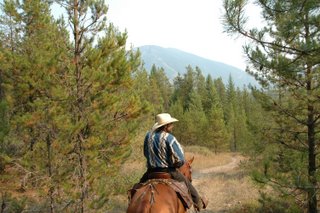
Whitewater rafting can be an adventure for the brave. My last whitewater trip involved two dozen Class 5 rapids in the course of a day, followed by a rugged quarter-mile hike out of a canyon. I swore I’d never take another.
Ah, but you voted for me to do a paddle saddle – a full day of rafting and horseback riding arranged by Wild River Adventures in West Glacier, Mont.
OK, here’s the secret: This is fall. And in fall in the northern hemisphere, most rivers are calm. Some are closed for the season.
So I was pretty sure I was in for a fairly tame ride, which suited me fine.
Our guide for the day, Chuck Hunter, took five of us on a leisurely, three-hour float from Moccasin Creek to the Flathead River, just outside Glacier National Park. The hills are covered with spruce, firs and hemlock sprinkled with shimmering Aspens just giving way to the yellows of autumn. It gave us plenty of time to admire the scenery and learn about the river when Big Water is the rule, bringing the levels up 8 to 15 feet above current levels. Now we were drifting at 600 cubic feet of water per second, but in spring the levels rise to 20,000-35,000 cubic feet per second. “It’s a different river every day,’’ he told us.
In between the ripples of whitewater, we admired the scenery and bemoaned the lack of funding for the National Parks. “It’s really important that we let people know what’s happening,’’ said Ruth Bradburn of Chicago. “It’s a major problem.’’
“Look at the color of that water coming over those rocks with the historic bridge in the background,’’ she marveled. “Now, that’s a memory for a cold Chicago winter day.’’
The afternoon “saddle’’ part of the day was proof that cowboy culture isn’t just the stuff of Western novels and vintage movies – at least not in Montana.
Dale Osteen, guide, took me through a forest of 40-foot lodgepole pines, so perfectly pointed they belong on the “grounds’’ of a child’s train set. Wild strawberries and huckleberries grow along the trail, their berries long consumed by forest creatures. But the knick-knicks – small red-berries with leaves once used by native peoples as tobacco – remain, with white winterberries and thimbleberries. The leaves have started reddening, dressing for the fall.
I rode Cheers, a sweet gelding whose young owner had sold him to pay for modeling school in New York.
When you ride, you chat. Dale regaled us with stories of horsemen injured in terrible accidents that would have killed lesser men, a young Australian horseman whose American colleagues were so envious of his abilities that they plotted to get him thrown from the country. A horse so good with austistic children that Dale had cried when the horse had to be put down.
He told us too, of a recent Florida couple who had gone with him on an overnight ride, only to run out of cigarettes. Instead of sitting around the campfire, the trio rode down to a nearby bar. “I think they liked that part of the trip best, the idea that they could ride their horse to a bar.’’
So, what if you have one too many? Not good, he told us; riding a horse while impaired qualifies at drunk driving. Happened to him once, years ago, in Bakersfield, Calif. Seems the judge didn’t think the horse qualified as a designated driver.
Tuesday, September 12, 2006
Paddle, then saddle
Posted by
DARCOS CRUZ
at
1:32 PM
![]()
![]()
Subscribe to:
Post Comments (Atom)


No comments:
Post a Comment